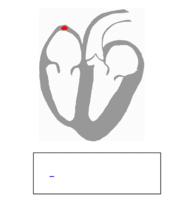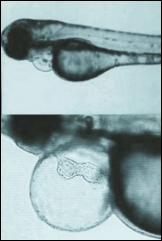
New Insights on the Control of the Heart Beat

Beating Heart. A mechanical sensor enables the heart to adapt to changing needs.
Source: Wikimedia Commons Author: Kalumet.
Use of this animation under the terms of GNU free documentation licence.
Source: Wikimedia Commons Author: Kalumet.
Use of this animation under the terms of GNU free documentation licence.
Within seconds, the heart is able to adapt its force of contraction. It recognizes changes in the extracellular environment and adjusts the beat rate. NGFN researcher elucidated a mechanism that enables the heart to fulfill this task: a mechanical stretch sensor recognizes changes in certain physiological parameter such as blood pressure or the blood filling of the heart and it sends signals to the heart muscle cells. These are then able to react appropriatly to meet the body's changing needs for oxygenated blood.
The NGFN research group headed by Dr. Wolfgang Rottbauer (University of Heidelberg) demonstrated that the protein ILK (integrin linked kinase) is an important component of the mechanical stretch sensor and plays a critical role for the ILK protein in regulating cardiac contractility. Up to now the molecular mechanisms, that lie behind the heart's ability to adjust its beat rate in response to environmental changes, were large unknown. However, experts already suspected that dysfunction of processes involving the mechanical stretch sensor is responsible for a significant proportion of human heart failure. Congestive heart failure is one of the most common illnesses and affects more than 10 million people in Europe.The NGFN scientist analyze a large number of zebrafish in order to discover the genetic causes of heart disease. Zebrafish offer cardiovascular researchers a number of advantages: at the beginning of their development the small fish embryos are transparent. The heart function can therefore be observed under a lifht-optical microscope in the living fish. Moreover, in the first ten days of their life, the little fish are not dependent on a healthy heart. They survive despite heart defects and their development can be observed.
During their study the NGFN researchers found a zebrafish mutant that carries a mutation in the ilk-gene. This zebrafish mutant loses the ability to recognize changes in blood pressure or the blood filling of the heart. As a consequence teh heart beat becomes progressively weaker and less efficient. Finally the heart stops beating.

As the small zebrafish embryos are relatively transparent (upper photo), researchers are able to observe the heart function under a light-optical microscope in the living fish (lower photo).
Analyzing the molecular mechanisms, that lie behind this mutation, the NGFN scientists discovered that he ILK protein behaves like a sensor. It is a component of a certain signaling pathway, which recognizes changes in the extracellular environment and sends signals within the cell to affect an appropriate cellular response. In particular, ILK turns on signaling mechanisms that relay mechanical changes to the central command of the cell, the cell nucleus. The cell nuleus directs the production of the hormones VEGF (vascular endothelial growth factor) and ANF (atrial natriuretic factor). Both hormones are essential for the regulation of the heart beat.
If ILK does not function correctly, this results in deficiency of VEGF and ANF and, as a further consequence, the heart pumps less efficiently. Rottbauer: "The results of this study provide new insights on the processes that enable our heart to react flexible and to adapt to changing needs. It is important to understand these mechanisms as this knowledge might result in new effective therapeutic strategies for heart disease"
![]() website of scientists involved
website of scientists involved




